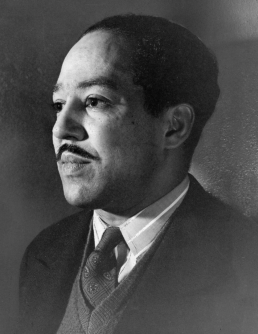These life stories may contain descriptions of childhood trauma and abuse, as well as images, voices and names of people now deceased. If you need help, you can find contact details for some relevant support services on our support page.
African American poet and playwright, Langston Hughes (1901-1967), was in kinship care and foster care.
James Mercer Langston Hughes was born in Joplin, Missouri to Carrie Langston (1873-1978) and James Nathaniel Hughes.
A year later, when James secured a position in Mexico City…Carrie dropped Langston off at her mother’s [in Lawrence, Kansas]… and followed him south. The couple bickered, reconciled, parted, sometimes with Langston in tow, often not; for the most part, the boy was reared by his judicious but loving grandmother, Mary (Als).
After his parents divorced in 1907, James Hughes moved to Mexico, and Langston was raised by Mary.
The boy experienced both racism – such as when a white teacher in primary school warned the child’s white classmates against eating licorice in case they ended up looking like him – and black pride when Mary took her grandson to Osawatomie where former President Theodore Roosevelt (1858-1919) honored her first husband, Lewis Sheridan Leary, who was killed during a raid on Harpers Ferry in 1859.
When Mary Langston died in 1915, Carrie left her son with family friends, the Reeds, until later that year Langston moved to Lincoln, Illinois and lived with his mother and stepfather. Here, and encouraged by his fellow students, Langston began writing poetry.
After the family relocated to Cleveland, Ohio, Langston wrote for his high school newspaper. He continued on at high school in Cleveland after his parents moved again. He graduated in 1920.
Hughes spent a year in Mexico then began studying at Columbia University, New York City, working a variety of jobs to support himself. He received a scholarship in 1926 to attend Lincoln University in Pennsylvania and graduated in 1929.
Langston published his first poetry in 1926.
Hughes’s first book of poetry, The Weary Blues, (Knopf, 1926) was published by Alfred A. Knopf in 1926 with an introduction by Harlem Renaissance arts patron Carl Van Vechten. Criticism of the book from the time varied, with some praising the arrival of a significant new voice in poetry, while others dismissed Hughes’s debut collection (poets.org).
Hughes travelled to the Soviet Union during the 1930s, attracted by communism, but returned to Harlem in New York City where he lived for the rest of his life.
Langston Hughes wrote a range of poetry, plays, novels and newspaper columns, most of which focused on the African American experience. He won a number of awards during his lifetime and was awarded two honorary doctorates. The Langston Hughes Middle School in Virginia was established in 1979 and the Langston Hughes High School was founded in Georgia in 2009.
Langston Hughes is considered a significant figure in the Harlem Renaissance, the “most influential movement in African American literary history” (Britannica).
In his memory, his residence at 20 East 127th Street in Harlem has been given landmark status by the New York City Preservation Commission, and East 127th Street has been renamed “Langston Hughes Place” (poets.org).
References:
Als, Hilton. “The Sojourner. The elusive Langston Hughes.” The New Yorker, 23 February 2015.
“Langston Hughes”. Britannica. https://www.britannica.com/biography/Langston-Hughes
Langston Hughes 1901-1967. Academy of American Poets, poets.org. https://poets.org/poet/langston-hughes
Image available here.
